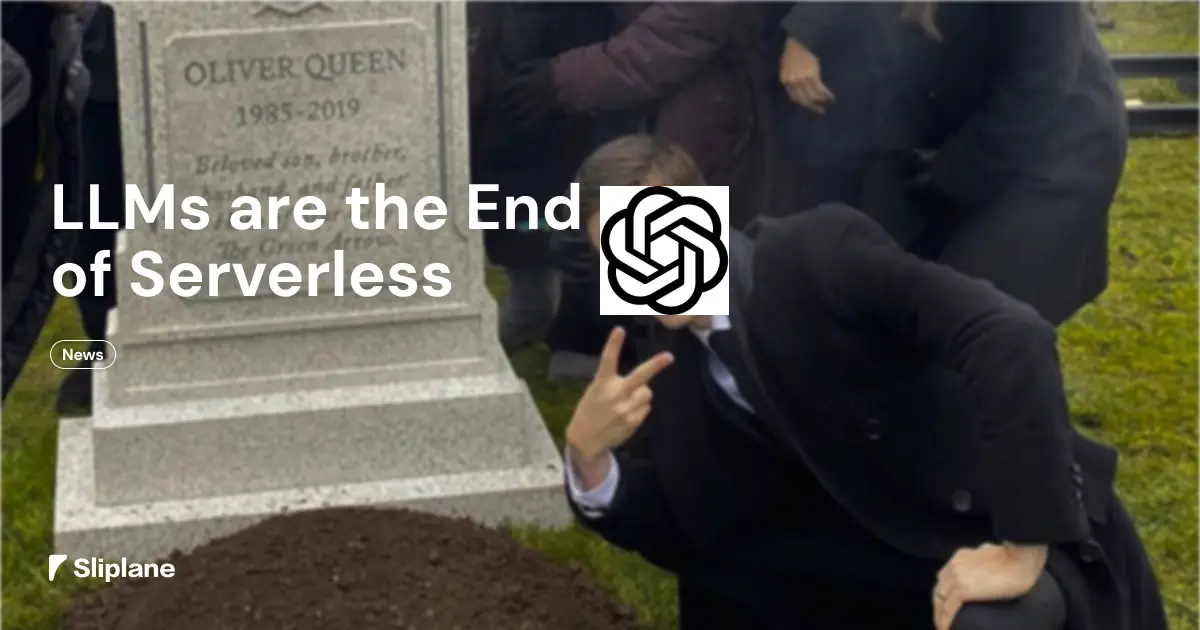
LLMs are the End of Serverless
 Jonas Scholz
Jonas ScholzRemember when serverless was going to revolutionize everything? Well, LLMs just delivered the killing blow.
Here's the thing: In an AI-assisted coding world, proprietary serverless platforms are dead weight. Why? Because LLMs understand Docker like they understand breathing, but they choke on your special snowflake Lambda configuration.
Let me explain why serverless was already a scam and how LLMs just made it ten times worse.
The Original Sin: Serverless Was Always Broken
Before we get to the LLM angle, let's recap why serverless was already a bad idea:
The Promise:
- No servers to manage!
- Infinite scale!
- Pay only for what you use!
The Reality:
- 15-minute execution limits
- Cold starts that make your app feel broken
- Surprise $10,000 bills
- Vendor lock-in so tight it hurts
- Debugging that makes you question your career choices
You know what doesn't have these problems? A container.
Enter LLMs: The Final Nail in the Coffin
Here's where it gets spicy.
When you're coding with Claude, ChatGPT, or Cursor, what works better?
Option A: "Deploy this to Docker"
docker build -t my-app .
docker run -p 3000:3000 my-app
Option B: "Deploy this to AWS Lambda with API Gateway, configure the execution role, set up the VPC endpoints, create a deployment package with the right runtime, configure the event source mappings..."
The LLM's response to Option B: confused screaming
Why LLMs Love Docker (And Hate Your Serverless Platform)
1. Documentation Density
Docker has been around since 2013. That's over a decade of:
- Stack Overflow answers
- GitHub examples
- Blog posts
- Official docs
- YouTube tutorials
AWS Lambda? Sure, there's documentation. But it's:
- Constantly changing
- Platform-specific
- Full of edge cases
- Buried in AWS's labyrinth of services
When an LLM trains on the internet, it sees 1000x more Docker examples than CloudFormation YAML nightmares.
2. Universal Patterns vs. Proprietary Nonsense
Docker is just Linux containers. The patterns are universal:
- Environment variables work the same everywhere
- Volumes are just mounted directories
- Networking is standard TCP/IP
Serverless? Every platform invents its own:
- Event formats
- Configuration syntax
- Deployment procedures
- Debugging tools
- Billing models
LLMs can't keep up with this Tower of Babel.
3. Local Development = Better LLM Assistance
Watch this:
Me: "Help me debug why my container isn't connecting to Redis"
LLM: "Let's check your docker-compose.yml, ensure the services are on the same network, verify the connection string..."
vs.
Me: "Help me debug why my Lambda can't connect to ElastiCache"
LLM: "First, check your VPC configuration, then the security groups, subnet associations, NAT gateway, execution role permissions, and... wait, are you using VPC endpoints? What about the Lambda ENI lifecycle? Did you enable DNS resolution in your VPC?"
head explodes

"But Serverless Scales!"
So does Kubernetes. So does Docker Swarm. So does literally any container orchestrator.
But here's the thing: with containers + LLMs, you can actually implement that scaling:
Me: "Add horizontal autoscaling to my Docker Compose setup"
LLM: "Here's a complete docker-compose.yml with scaling configuration, health checks, and load balancing..."
vs.
Me: "Add autoscaling to my Lambda"
LLM: "First, create an Application Auto Scaling target, then define a scaling policy using CloudWatch metrics, but make sure your concurrent execution limits don't interfere with account limits, and don't forget about reserved concurrency vs provisioned concurrency..."
Which one are you actually going to implement correctly?
Breaking Free: The Container + LLM Combo
Here's your escape plan:
- Pick boring technology: Docker, PostgreSQL, Redis
- Use standard patterns: REST APIs, background workers, cron jobs
- Deploy anywhere: VPS, Kubernetes, even Sliplane (yes, shameless plug)
- Let LLMs actually help: They understand these tools
Your AI assistant becomes a force multiplier instead of a confused intern.
The Future Is Boring (And That's Beautiful)
We're entering an era where AI can write most of our code. But it can only write code for platforms it understands.
Docker is boring. PostgreSQL is boring. Redis is boring.
You know what? Boring means:
- Documented
- Predictable
- LLM-friendly
- Actually works
Serverless is "exciting": excitingly broken, excitingly expensive, excitingly impossible to debug.
TL;DR
Serverless was already a questionable choice. Now that we code with LLMs, it's practically sabotage.
Your AI assistant can spin up a complete containerized application in seconds. But ask it to debug your Lambda cold start issues? Good luck.
The writing's on the wall: In an LLM-powered development world, proprietary platforms are dead weight. Stick to technologies with deep documentation, wide adoption, and standard patterns.
Or keep fighting with CloudFormation while your competitors ship features. Your choice.
Cheers,
Jonas, Co-Founder of sliplane.io